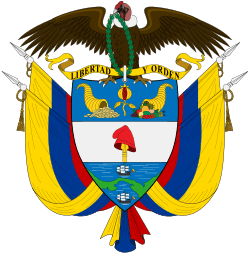Colombia–Spain relations
 |
|
Colombia |
Spain |
|---|---|
Colombian-Spain relations are the bilateral relations between the Kingdom of Spain and the Republic of Colombia, formally established in 1881, several decades after Colombia's independence from the Spanish Empire.
History
Colonial times
The territory that became Colombia was first visited by Europeans when the first expedition of Alonso de Ojeda arrived at the Cabo de la Vela in 1499. The Spanish made several attempts to settle along the north coast of today's Colombia in the early 16th century, but their first permanent settlement, at Santa Marta, was not established until 1525. Cartagena was founded on June 1, 1533 by Spanish commander Pedro de Heredia, and grew rapidly, fueled first by the gold in the tombs of the Sinú culture, and later by trade.
The Spanish advance from inland from the Caribbean coast began independently from three different directions, under Jimenéz de Quesáda, Sebastián de Belalcázar and Nicolas de Federmann. Although all three were drawn by the Indian treasures, none intended to reach Muisca territory, where they finally met.[1] In August 1538 Quesáda founded Santa Fe de Bogotá on the site of Muisca village of Bacatá.
In 1549, the Spanish Royal Audiencia made Bogotá the capital of New Granada, which comprised in large part what is now territory of Colombia. In 1717, the Viceroyalty of New Granada was originally created, with Santa Fé de Bogotá as its capital. This Viceroyalty included some other provinces of northwestern South America which had previously been under the jurisdiction of the Viceroyalties of New Spain or Peru and correspond mainly to today's Venezuela, Ecuador and Panama. Bogotá thus became one of the principal administrative centers of the Spanish possessions in the New World.
Independence

A movement initiated by Antonio Nariño, who opposed Spain's centralism and led the opposition against the viceroyalty, leading to the independence of Cartagena in November 1811, and the formation of two independent governments which fought a civil war – a period known as La Patria Boba. The following year Nariño proclaimed the United Provinces of New Granada, headed by Camilo Torres Tenorio. Despite the successes of the rebellion, the emergence of two distinct ideological currents among the liberators (federalism and centralism) gave rise to an internal clash which contributed to the reconquest of territory by the Spanish. The viceroyalty was restored under the command of Juan de Samano, whose regime punished those who participated in the uprisings. Renewed rebellion, combined with a weakened Spain, made possible a successful rebellion led by the Venezuelan-born Simón Bolívar, who finally proclaimed independence in 1819. The pro-Spanish resistance was finally defeated in 1822 in the present territory of Colombia and in 1823 in Venezuela.
The territory of the Viceroyalty of New Granada became the Republic of Colombia organized as a union of Ecuador, Colombia (including modern-day Panama) and Venezuela. The Congress of Cúcuta in 1821 adopted a constitution for the new Republic, and Simón Bolívar became the first President of Colombia. However, the new republic was unstable and ended with the rupture of Venezuela in 1829 and Ecuador in 1830.
Embassies and consulates
- Colombia has an embassy in Madrid[2] and consulates-general in Barcelona[3] Bilbao,[4] Las Palmas,[5] Palma[6] Seville,[7] and Valencia.[8]
- Spain has an embassy in Bogotá[9] and a consulate-general in Cartagena.[10]
See also
References
- ↑ Lonely Planet, "History of Colombia", http://www.lonelyplanet.com/colombia/history. Accessed 6 May 2013.
- ↑ Embassy of Colombia in Madrid (in Spanish)
- ↑ Consulate-General of Colombia in Barcelona (in Spanish)
- ↑ Consulate-General of Colombia in Bilbao (in Spanish)
- ↑ Consulate-General of Colombia in Las Palmas (in Spanish)
- ↑ Consulate-General of Colombia in Palma (in Spanish)
- ↑ Consulate-General of Colombia in Seville (in Spanish)
- ↑ Consulate-General of Colombia in Valencia (in Spanish)
- ↑ Embassy of Spain in Bogotá (in Spanish)
- ↑ Consulate-General of Spain in Cartagena (in Spanish)

.svg.png)